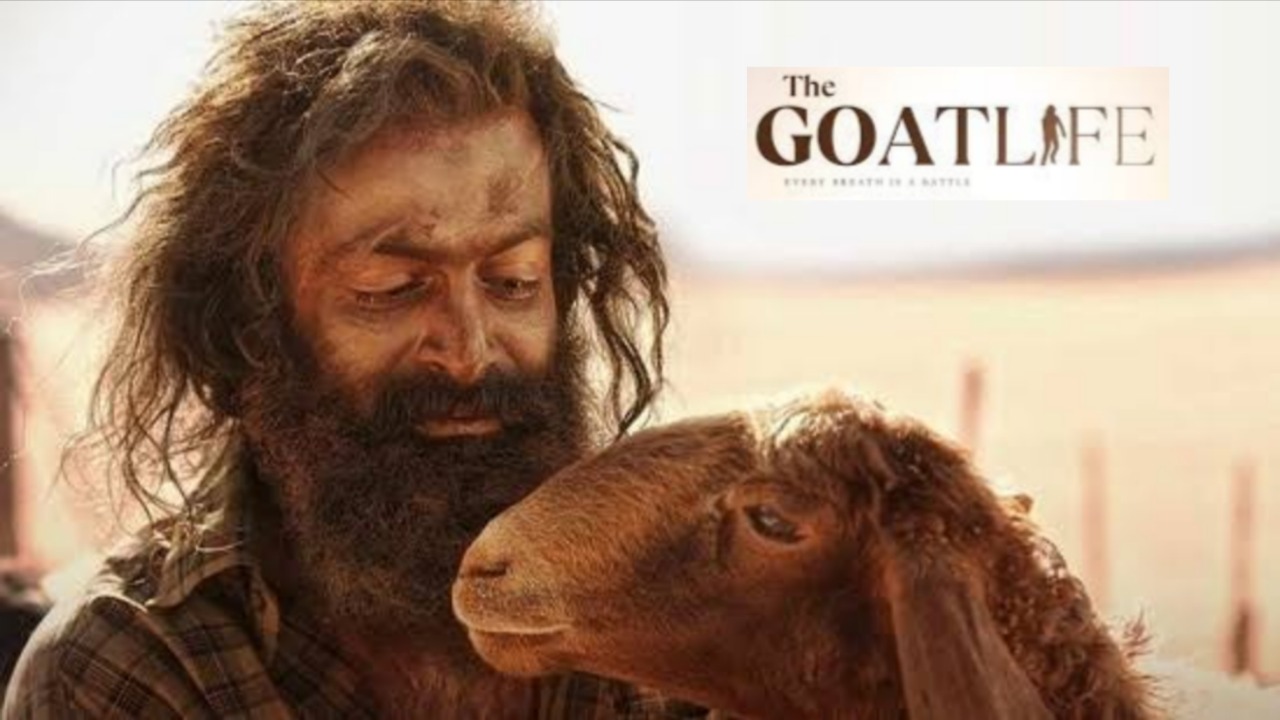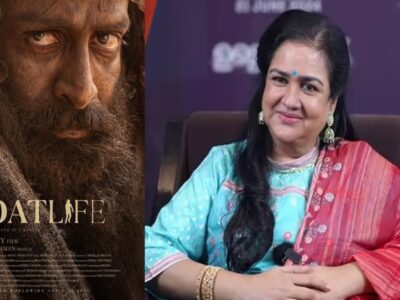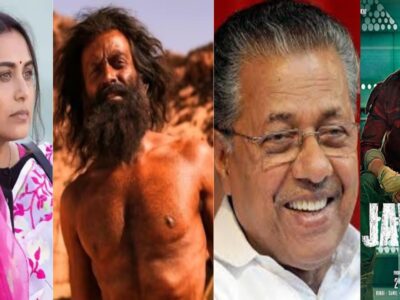Too Honest, Too Human, Too Real for Awards: The Aadujeevitham Snub
Why Aadujeevitham (The Goat Life) Deserves Recognition—And Why Prithviraj Sukumaran’s Performance Should Not Be Overlooked?
There is an ongoing joke that whenever a movie upholds artistic values and stirs humanity in viewers, it is labelled an “art film.” But is there really a difference between an art film and an entertaining film—or does the difference lie with the audience? Even those lines between artistic cinema and commercial cinema are blurred with the national award choices since past few years.
Yes, in the past, many films and actors have been snubbed at the National Awards. But why is there such unanimous and continuous outrage against the omission of Aadujeevitham in particular?
The Transformation of a Textbook Hero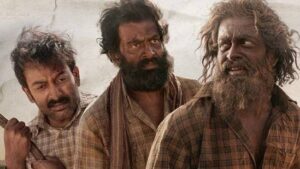 For one, Prithviraj Sukumaran is tall, well-built, and—at first glance—fits the mold of a textbook action hero. But in The Goat Life, he begins as a slightly overweight, healthy, and happy man. In most films, when a man like that is trapped or confined, he breaks free through force, becoming a “mass hero” who fights his way out. That’s the typical commercial formula we’ve grown used to.
For one, Prithviraj Sukumaran is tall, well-built, and—at first glance—fits the mold of a textbook action hero. But in The Goat Life, he begins as a slightly overweight, healthy, and happy man. In most films, when a man like that is trapped or confined, he breaks free through force, becoming a “mass hero” who fights his way out. That’s the typical commercial formula we’ve grown used to.
But here, when Najeeb (played by Prithviraj) realizes he has been cheated and trapped, we see genuine fear in his eyes. His body trembles, his entire being shakes. In that moment, we don’t see a “hero”—we see a helpless man. Despite his size, he is beaten and dominated by an older, shorter man. Every time, it feels like he could easily overpower him—but he doesn’t. Instead, we see a strong man curl up on the floor, stripped of dignity.
This Is Not a Normal Role This isn’t a typical role where the actor just delivers a few lines, dances, and entertains. It’s a role that demands physical and emotional transformation—one where a strong, healthy man becomes an unrecognizable, fragile shadow of himself.
This isn’t a typical role where the actor just delivers a few lines, dances, and entertains. It’s a role that demands physical and emotional transformation—one where a strong, healthy man becomes an unrecognizable, fragile shadow of himself.
We don’t see Prithviraj Sukumaran—we see Najeeb. We don’t feel bad that an actor is portraying this—we feel the pain of a human being undergoing unimaginable suffering.
A Stunning Visual Experience And don’t even get started on the picturesque cinematography—the desert skies, the barren land, the water, the forests. Everything that is untouched by human intervention is shown in its raw beauty.
And don’t even get started on the picturesque cinematography—the desert skies, the barren land, the water, the forests. Everything that is untouched by human intervention is shown in its raw beauty. These natural elements are not explained, not glorified—just shown as they are, making them all the more powerful. This element was captured brilliantly, just like in the book and reflected in the film’s visuals.
These natural elements are not explained, not glorified—just shown as they are, making them all the more powerful. This element was captured brilliantly, just like in the book and reflected in the film’s visuals.
Faithful Spirit, Even If Not Fully Accurate The filmmakers have openly stated that the movie is not fully accurate to the book. Not everything from the book has been shown. But one thing is certain: Prithviraj Sukumaran was the problem in this film.
The filmmakers have openly stated that the movie is not fully accurate to the book. Not everything from the book has been shown. But one thing is certain: Prithviraj Sukumaran was the problem in this film.
A Story of Two Main Characters: Najeeb and the Goats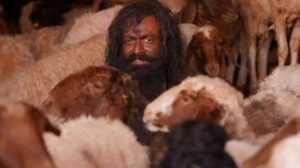 The movie essentially has two main characters—Najeeb, and the goats he lives with. There aren’t many conversations like in most mainstream films, yet we understand everything through Prithviraj’s expressions and body language.
The movie essentially has two main characters—Najeeb, and the goats he lives with. There aren’t many conversations like in most mainstream films, yet we understand everything through Prithviraj’s expressions and body language.
A Glimpse into a Few Scenes – Like a Drop in the River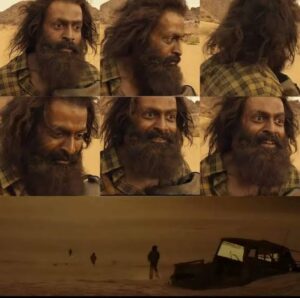 One unforgettable moment is when Najeeb sees himself in the mirror after months of living like a goat. The breakdown happens in stages: First, shock—who is this person? Then, recognition — slowly realising that it’s him. Then, touching his face, pulling his facial hair—remembering the clean-shaven man he used to be. Finally, the grief of what he has become.
One unforgettable moment is when Najeeb sees himself in the mirror after months of living like a goat. The breakdown happens in stages: First, shock—who is this person? Then, recognition — slowly realising that it’s him. Then, touching his face, pulling his facial hair—remembering the clean-shaven man he used to be. Finally, the grief of what he has become.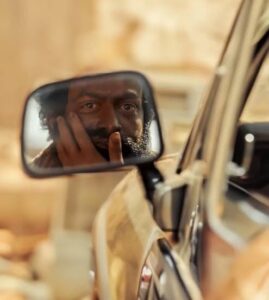 Take a look at the juxta-positioned image above, in this scene, where he finally escapes, he looks back one last time, reflecting on the animals he lived with—then, with a spark of hope and visible excitement in his eyes, he moves forward to make his escape.
Take a look at the juxta-positioned image above, in this scene, where he finally escapes, he looks back one last time, reflecting on the animals he lived with—then, with a spark of hope and visible excitement in his eyes, he moves forward to make his escape.
Water—The Touch He Misses the Most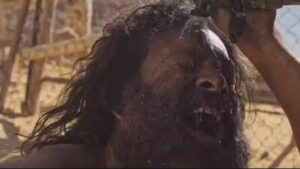 The film also portrays how Najeeb, once a man who dove deep into water for a living, is now deprived of water—not just to drink, but to feel. His skin longs for its touch. He dreams constantly of his family and his past life.
The film also portrays how Najeeb, once a man who dove deep into water for a living, is now deprived of water—not just to drink, but to feel. His skin longs for its touch. He dreams constantly of his family and his past life. Surviving Without Dying
Surviving Without Dying
The film captures the reality of a man who, despite living like an animal, does not die by choice. He survives day by day, waiting for his chance to go home. He tries, in every way, to live like the goats around him—just to make it through.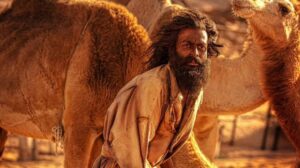 The music: A soul touching music that enhanced every step of Najeeb’s journey.
The music: A soul touching music that enhanced every step of Najeeb’s journey.
Prithviraj’s Humility and Craft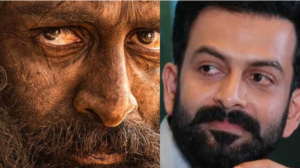 Despite his fame, multilingual career, and status, Prithviraj has never acted like a star. His humility shines through, especially in a time when many are treated like gods for being nothing more than social media influencers.
Despite his fame, multilingual career, and status, Prithviraj has never acted like a star. His humility shines through, especially in a time when many are treated like gods for being nothing more than social media influencers.
In Aadujeevitham, he doesn’t act like a “nepo kid” or an industry insider. He becomes someone he’s only read about. His face, body, and gait change. He’s not a hero in the typical sense—but he’s a hero of acting.
We don’t cry during the film because the actor is crying. We cry because we forget there’s an actor at all—we only see a human being in pain. That’s what Prithviraj Sukumaran accomplished in Aadujeevitham.
His Humble Words Say It All
Even today, Prithviraj says he never chased awards—he only wanted the story to reach people. In his words: “I wanted the film to work. I wanted people to like my performance and most importantly I wanted the world to know about that man’s story. All three happened.”
Whether it is political or apolitical, when the whole India is standing with an actor, against the so-called jury and straight out calls it an agenda, what more can we say about the state of our country’s affairs?
Indian cinema has largely shifted towards entertaining audiences, which, in turn, negatively affects the essence of the art form. Cinema—which should be about storytelling, character depth, or visual artistry—has increasingly become focused on outcomes: how a film benefits a certain group, or how much money it makes.
Cinema is a powerful medium, but how justified are we in using it merely as a tool for return on investment, rather than as a form of artistic expression?


